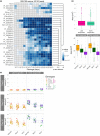High-throughput profiling and analysis of plant responses over time to abiotic stress
- PMID: 31245669
- PMCID: PMC6508565
- DOI: 10.1002/pld3.23
High-throughput profiling and analysis of plant responses over time to abiotic stress
Abstract
Sorghum (Sorghum bicolor (L.) Moench) is a rapidly growing, high-biomass crop prized for abiotic stress tolerance. However, measuring genotype-by-environment (G x E) interactions remains a progress bottleneck. We subjected a panel of 30 genetically diverse sorghum genotypes to a spectrum of nitrogen deprivation and measured responses using high-throughput phenotyping technology followed by ionomic profiling. Responses were quantified using shape (16 measurable outputs), color (hue and intensity), and ionome (18 elements). We measured the speed at which specific genotypes respond to environmental conditions, in terms of both biomass and color changes, and identified individual genotypes that perform most favorably. With this analysis, we present a novel approach to quantifying color-based stress indicators over time. Additionally, ionomic profiling was conducted as an independent, low-cost, and high-throughput option for characterizing G x E, identifying the elements most affected by either genotype or treatment and suggesting signaling that occurs in response to the environment. This entire dataset and associated scripts are made available through an open-access, user-friendly, web-based interface. In summary, this work provides analysis tools for visualizing and quantifying plant abiotic stress responses over time. These methods can be deployed as a time-efficient method of dissecting the genetic mechanisms used by sorghum to respond to the environment to accelerate crop improvement.
Keywords: abiotic stress; computational modeling; image analysis; ionomics; large‐scale biology; nitrogen stress.
Figures






Similar articles
-
Capturing crop adaptation to abiotic stress using image-based technologies.Open Biol. 2022 Jun;12(6):210353. doi: 10.1098/rsob.210353. Epub 2022 Jun 22. Open Biol. 2022. PMID: 35728624 Free PMC article. Review.
-
Enhancement of Plant Productivity in the Post-Genomics Era.Curr Genomics. 2016 Aug;17(4):295-6. doi: 10.2174/138920291704160607182507. Curr Genomics. 2016. PMID: 27499678 Free PMC article.
-
Multi-Species Prediction of Physiological Traits with Hyperspectral Modeling.Plants (Basel). 2022 Mar 1;11(5):676. doi: 10.3390/plants11050676. Plants (Basel). 2022. PMID: 35270145 Free PMC article.
-
Cross-species multiple environmental stress responses: An integrated approach to identify candidate genes for multiple stress tolerance in sorghum (Sorghum bicolor (L.) Moench) and related model species.PLoS One. 2018 Mar 28;13(3):e0192678. doi: 10.1371/journal.pone.0192678. eCollection 2018. PLoS One. 2018. PMID: 29590108 Free PMC article.
-
Current advances in the molecular regulation of abiotic stress tolerance in sorghum via transcriptomic, proteomic, and metabolomic approaches.Front Plant Sci. 2023 May 10;14:1147328. doi: 10.3389/fpls.2023.1147328. eCollection 2023. Front Plant Sci. 2023. PMID: 37235010 Free PMC article. Review.
Cited by
-
Identification of beneficial and detrimental bacteria impacting sorghum responses to drought using multi-scale and multi-system microbiome comparisons.ISME J. 2022 Aug;16(8):1957-1969. doi: 10.1038/s41396-022-01245-4. Epub 2022 May 6. ISME J. 2022. PMID: 35523959 Free PMC article.
-
Exploiting High-Throughput Indoor Phenotyping to Characterize the Founders of a Structured B. napus Breeding Population.Front Plant Sci. 2022 Jan 5;12:780250. doi: 10.3389/fpls.2021.780250. eCollection 2021. Front Plant Sci. 2022. PMID: 35069637 Free PMC article.
-
Antiviral ARGONAUTEs Against Turnip Crinkle Virus Revealed by Image-Based Trait Analysis.Plant Physiol. 2019 Jul;180(3):1418-1435. doi: 10.1104/pp.19.00121. Epub 2019 May 1. Plant Physiol. 2019. PMID: 31043494 Free PMC article.
-
ROSE-X: an annotated data set for evaluation of 3D plant organ segmentation methods.Plant Methods. 2020 Mar 4;16:28. doi: 10.1186/s13007-020-00573-w. eCollection 2020. Plant Methods. 2020. PMID: 32158494 Free PMC article.
-
Capturing crop adaptation to abiotic stress using image-based technologies.Open Biol. 2022 Jun;12(6):210353. doi: 10.1098/rsob.210353. Epub 2022 Jun 22. Open Biol. 2022. PMID: 35728624 Free PMC article. Review.
References
LinkOut - more resources
Full Text Sources

